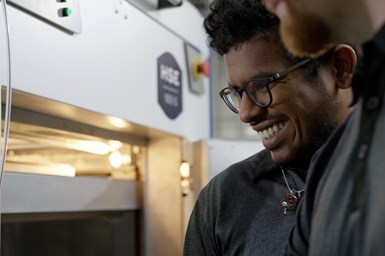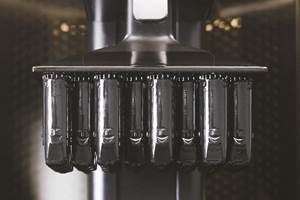Nexa3D Signs Letter of Intent to Acquire Essentium
Acquisition would broaden capabilities, expand addressable markets and diversify revenues for Nexa3D.
Nexa3D has signed a letter of intent to acquire Essentium, a manufacturer of high-speed extrusion (HSE) 3D printers and materials, which are well suited for high-requirement, precision applications in aerospace, military and defense. With this acquisition, Nexa3D plans to add HSE to its product portfolio.
Nexa3D has rapidly grown in the industrial 3D printing space, working to deliver groundbreaking production solutions for businesses across various sectors. Best known for its ultrafast 3D printers — ranging from desktop to the factory floor — its technology has created new possibilities for 3D printing production, enabling productivity, accuracy and material flexibility. Adopted by more than 1,200 customers worldwide, its printers have become the go-to solution for many high-throughput, production applications.
Essentium — known for its broad materials portfolio; award-winning, high-speed extrusion 3D printers; and true independent dual extruders (IDEX) — has carved a niche in the industry by providing solutions for complex polymer production applications that are 5 to 15 times faster than competing extrusion technologies, the company says. The company’s commitment to innovation and reliability has also made it a choice for many manufacturers and government users worldwide.
This marks the beginning of a collaboration that the company hopes to transform the 3D printing landscape. The combination of Nexa3D’s expertise in ultrafast 3D printing with Essentium’s mastery of high-speed extrusion technology could result in a powerhouse of production technologies, ultimately benefiting industries ranging from aerospace and defense to medical device and consumer goods.
“We are looking forward to welcoming the Essentium team to Nexa3D’s growing family,” says Avi Reichental, Nexa3D co-founder, chairman and CEO. “This acquisition will be a testament to our unwavering commitment to pushing the boundaries of 3D printing technology. By joining forces with Essentium, we aim to create synergies that will deliver unmatched value to our customers. Together, we will drive ultrafast additive manufacturing innovation and provide even more powerful solutions for manufacturers seeking to achieve their production goals.”
Nexa3D’s acquisition of Essentium is aiming to open new possibilities in additive manufacturing (AM). The melding of Nexa3D’s ultrafast 3D printing capabilities and broad market reach with over 120 worldwide resellers with Essentium's HSE technology can provide industrial customers with tools to scale AM and create previously unattainable production opportunities.
“We believe that our joint expertise will disrupt the industrial 3D printing market in a profound way. Nexa3D and Essentium share a vision of empowering manufacturers to create what was once considered impossible,” says Blake Teipel, Essentium CEO. “Our alignment will enable us to offer game-changing 3D printing solutions for our clients. When we considered potential combination partners from around the industry, we were blown away by the growth, technology and delivery velocity underpinning Nexa3D. We feel we are joining a team of fast movers, similar in mindset to our own, and we look forward to enabling greater adoption of industrial AM together for years into the future.”
Following customary shareholder and regulatory approvals and governmental filings, the acquisition is expected to close by the end of this calendar year or as soon as practicable afterward. Both Nexa3D and Essentium say they are committed to ensuring a smooth transition and maintaining uninterrupted service to existing and prospective customers.
- Earlier this year, Nexa3D acquired Addifab. The maker of polymer 3D printers and the creator of technology for injection-molding-ready printed tooling are fully joined after announcing a collaboration last year.
- Learn more about HSE in this article about the German National Railway certifying Essentium HSE printing platform and materials. Essentium’s additive manufacturing solutions will enable Deutsche Bahn to increase its fleet availability through easy and fast replacement of parts and tools.
Related Content
Possibilities From Electroplating 3D Printed Plastic Parts
Adding layers of nickel or copper to 3D printed polymer can impart desired properties such as electrical conductivity, EMI shielding, abrasion resistance and improved strength — approaching and even exceeding 3D printed metal, according to RePliForm.
Read MoreWhat is Powder Bed Fusion 3D Printing?
Whether in metal or polymer, with a laser or an electron beam, powder bed fusion (PBF) is one of the most widely used 3D printing techniques.
Read More3D Printing with Plastic Pellets – What You Need to Know
A few 3D printers today are capable of working directly with resin pellets for feedstock. That brings extreme flexibility in material options, but also requires greater knowledge of how to best process any given resin. Here’s how FGF machine maker JuggerBot 3D addresses both the printing technology and the process know-how.
Read MoreAM 101: Digital Light Synthesis (DLS)
Digital Light Synthesis (DLS) is the name for Carbon's resin-based 3D printing process. How it works and how it differs from stereolithography.
Read MoreRead Next
Hybrid Additive Manufacturing Machine Tools Continue to Make Gains (Includes Video)
The hybrid machine tool is an idea that continues to advance. Two important developments of recent years expand the possibilities for this platform.
Read More4 Ways the Education and Training Challenge Is Different for Additive Manufacturing
The advance of additive manufacturing means we need more professionals educated in AM technology.
Read More3D Printing Brings Sustainability, Accessibility to Glass Manufacturing
Australian startup Maple Glass Printing has developed a process for extruding glass into artwork, lab implements and architectural elements. Along the way, the company has also found more efficient ways of recycling this material.
Read More






















